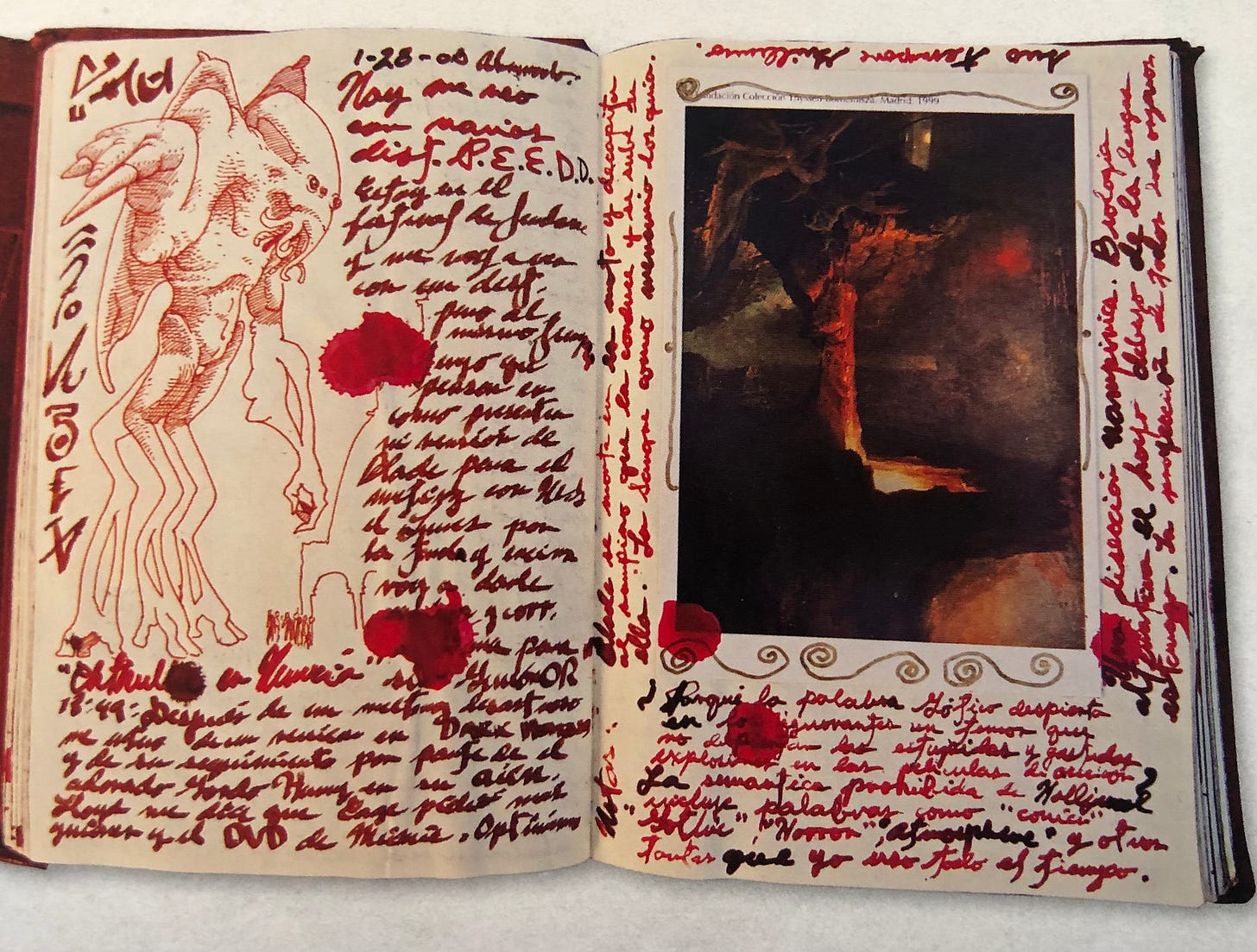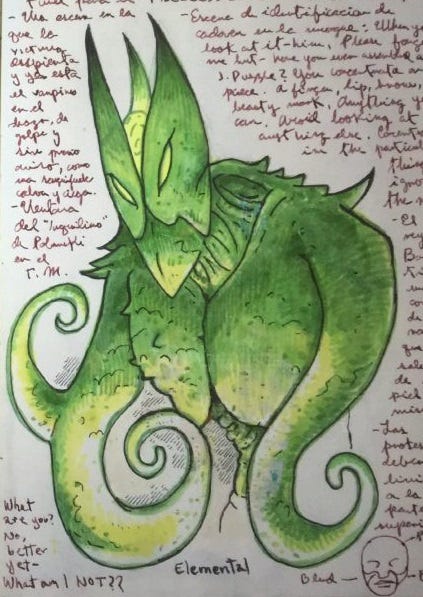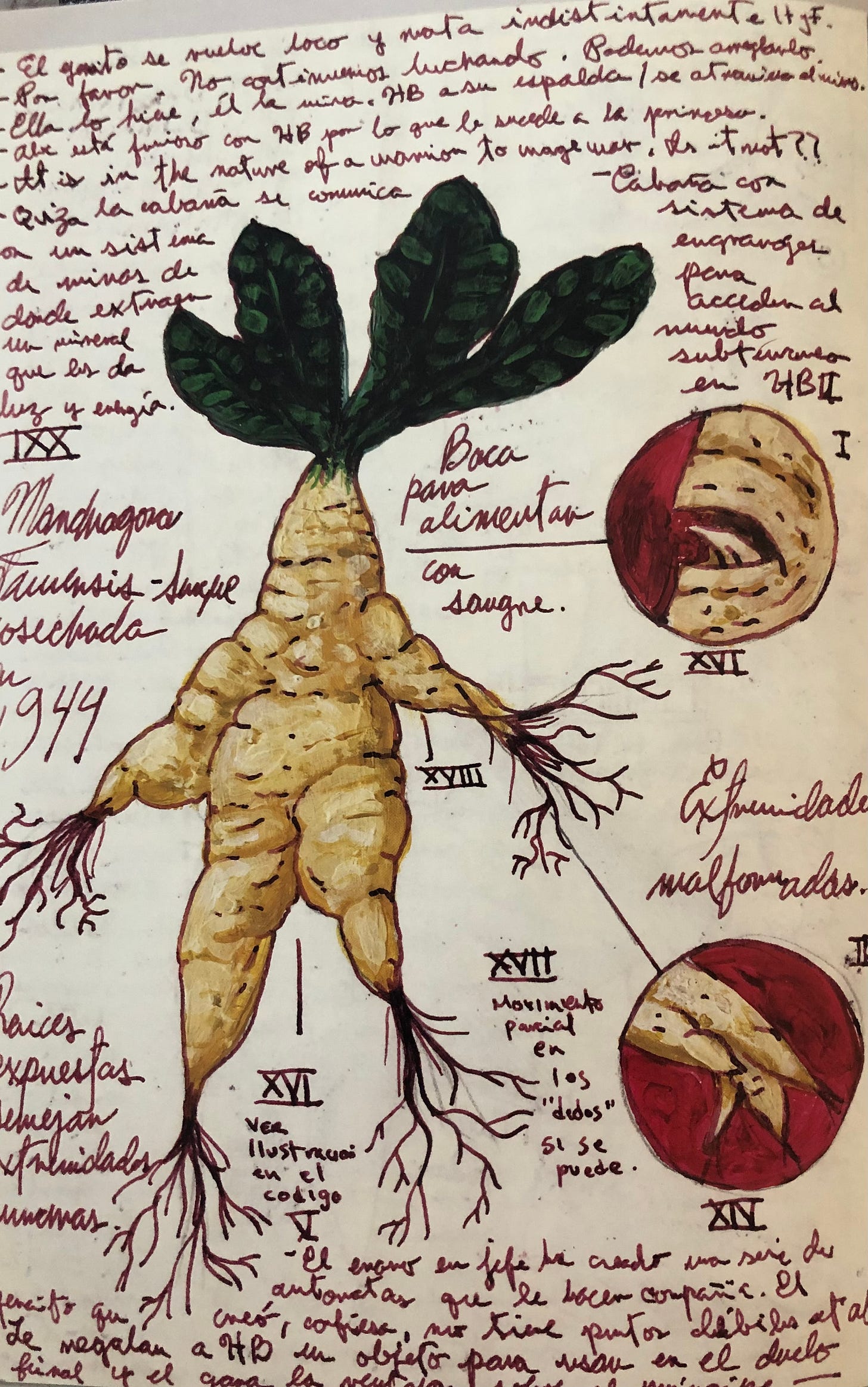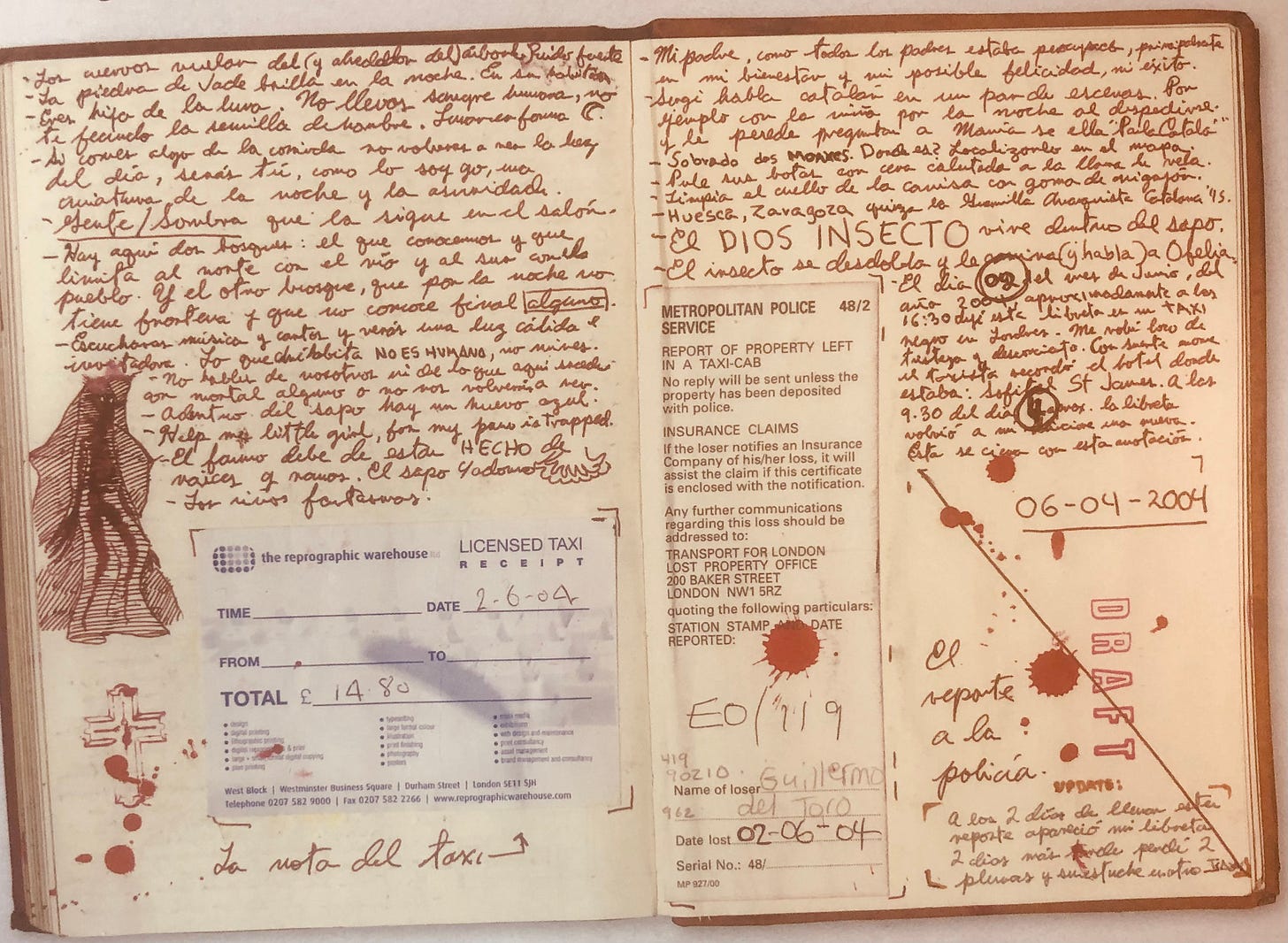Re-Noted Guillermo del Toro's Mystical Notes
"I always say, everything that happens is a ciphered message…"
Guillermo del Toro’s notes have a mystical quality to them. Like the books in his films, they are grimoires (books of magical spells). As I read through his notes, I kept thinking of “The Book of Crossroads” in Pan’s Labyrinth. When Fauno gives Ofelia this book, it is blank. However, once she is alone, words and images magically appear to guide our hero through the labyrinth.
“The Book of Crossroads” appears in the film’s trailer:
Notice, too, how within the labyrinth, a piece of chalk can create real openings in stone walls. Pan’s Labyrinth pays homage to the power of reading and writing. The items Ofelia interacts with are all talismans (objects with magical powers). And, this is precisely how Guillermo del Toro thinks about his notebooks:
It’s important in our life to have talismans. Everybody has one or two or three. In my case, I have dozens. You have to imbue things that surround you with power.1
As the writer of Pan’s Labyrinth, Hellboy, and Pinocchio, Guillermo inhabits a magical world. And his fantastical creations develop within the pages of his notebooks.
Guillermo wants his notebooks to look like “found objects”— like the magical books featured in his films. In one of his notebooks, he writes in red ink and covers the page in splotches that resemble blood. He says,
I found the right color for blood, and I thought it looked good to have it, so that it started to look like a found grimoire…2

So, let’s explore the mystical world within Guillermo’s notebooks.
Guillermo’s Drawings
Guillermo began taking notes at the insistence of his mentor, Jaime Humberto Hermosillo. At first, Guillermo carried a tape recorder to store his ideas. But he lost it— and with it, his notes.3
So, he began recording his thoughts in notebooks —famously, he lost a notebook too, but we’ll get to that in a bit.
Guillermo begins with drawings and then adds in words.
…if I do a drawing I try to organize notes around it.4

Guillermo draws faster than he writes. Often, the images and text on a single page relate to different projects. He explains,
I might be five pages ahead of the writing with the drawing. So I write around the drawings, which means the images and text connect only tangentially.5
As Guillermo prepares to make a movie, he reads through all of his notebooks. But they are not well-ordered thoughts. They are like “a mail order catalog of ideas…”6 When he’s running low on inspiration, he flips through his notebooks.
Just before a movie goes into production, Guillermo returns to his notebooks to finalize his drawings.
Here, he shows Jimmy Kimmel a recent notebook with drawings for Nightmare Alley.
Guillermo’s Process
Visual details matter to Guillermo—so does character development. He writes “8 to 10 pages of biography on each character, including what they eat, drink, listen to, watch, like and dislike.”7 Pages in the notebook contain a mixture of historical background, dialogue, and character sketches, all surrounding Guillermo’s distinctive drawings.
Guillermo’s pages are busy—in terms of visual material and content. For example, most pages contain notes for multiple projects. Writing this way adds a dynamic quality to the notebooks that Guillermo finds helpful. He explains,
The mental promiscuity of having four or five things going at once in the notebooks makes them feed off one another.8
Consider the following page which contains notes for Pan’s Labyrinth and Hellboy (abbreviated as HB):

Guillermo’s bullet points at the top contain notes for Hellboy:
..Abe is furious with HB because of what happens to the princess.
It is in the nature of a warrior to wage war. Is it not?
The cabin could be connected to a system of mines in which a mineral that gives them light and energy is extracted…
These notes are followed by an elaborate drawing (with close-ups) of a mandrake—the root of a plant. Many legends surround the mandrake.9 One of them is that the root will transform into a baby with the right nourishment. In Pan’s Labyrinth, Ofelia uses a mandrake-baby to heal her pregnant mother. Ofelia places the mandrake in milk and feeds it with drops of her own blood. You can watch this 1-minute scene here:
In Guillermo’s drawing, the roman numerals refer to different parts of the mandrake, along with explanations and close-ups of specific parts of the root—including the “mouth” and “fingers”:
XVI Mouth for food / with blood
Deformed Limbs
XVII Partial movement in the “fingers” if possible.
Exposed roots resemble human limbs.
The idea of the mandrake developed in Guillermo’s notebooks. By the time Raúl Monge created Pan’s storyboards, it had lost its leaves. Here is Ofelia, under the bed with the mandrake:

Guillermo’s Lost Notebook
In 2004, Guillermo left a notebook with ideas for Pan’s Labyrinth in the back of a London taxi. At the time, he was at a professional crossroad. Marvel Studios had approached him to work on The Fantastic Four. Guillermo couldn’t decide if he should take on the Marvel project or work on Pan’s Labyrinth—the riskier project.
When he lost this notebook, he cried. He spent all night meditating on the significance of losing this notebook at this time. Finally, it occurred to him that he lost the notebook “because I was about to lose myself.” He decided to do Pan’s Labyrinth.
And then the phone rang.
The cab driver had brought the notebook to Guillermo’s hotel. This confirmed Guillermo’s belief:
I always say, everything that happens is a ciphered message…10
Guillermo credits losing his notebook with his decision to take on the riskier project that would become Pan’s Labyrinth. To commemorate the event, Guillermo pasted in his receipt from the taxi ride as well as the police report he had filed. Here it is:

Guillermo’s Will
At his death, Guillermo’s daughters will inherit the notebooks. He has been writing notes not only for himself, but also for them. With his first daughter’s birth, he decided he would turn his notes into an art project that she would enjoy reading. He writes,
I changed my handwriting, did the elongated T’s and elongated L’s to give it an old fashioned feel, bought a quill…every note that is there is not to myself, but to her.11
The birth of his second daughter only intensified his intention to turn his notebooks into an inheritance.12 What will the daughters learn about their father from reading his notebooks? According to Guillermo, the notebooks are
a testament to curiosity. I think they indicate not how much I know, but how much I want to know…13
Notes on Guillermo del Toro’s Notes:
Write imperfect notes: Guillermo intentionally keeps flawed notebooks. He includes deliberate stains (like drops of red ink that look like blood). He tells us:
In the end, perfection is just a concept —an impossibility we use to torture ourselves…
It doesn’t matter if your notes are well-organized. Disorganized notes allow diverse ideas to bump up against one another—this could result in happy coincidences.
Fill the page: Guillermo draws images first and then fills up the rest of the page with words. But these words don’t necessarily relate to the images. He just wants to fill the page with ideas.
Notebooks are chronicles of what you want to know. Guillermo teaches us to think of notebooks as maps to our curiosity.
Yours in note-taking,
Toro, Guillermo del, and Marc Zicree. Guillermo del Toro Cabinet of Curiosities: My Notebooks, Collections, and Other Obsessions. First Edition, Harper Design, 2013, p. 23.
Cabinet of Curiosities, p.72.
Cabinet of Curiosities, p.22.
Cabinet of Curiosities, p. 72.
Cabinet of Curiosities, p. 72.
Cabinet of Curiosities, p.72.
Crist, Allison. “Guillermo del Toro on His Filmmaking Process and Love of Monsters.” The Hollywood Reporter, 26 Apr. 2019, https://www.hollywoodreporter.com/movies/movie-news/guillermo-del-toro-his-filmmaking-process-love-monsters-1205038/.
Cabinet of Curiosities, p.73.
There are many other myths surrounding mandrakes. It is also worth noting that the Mandragora has hallucinogenic qualities. For more, check out Angelica Calabrese’s article, “The History and Uses of the Magical Mandrake, According to Modern Witches.” Atlas Obscura.
Cabinet of Curiosities, p.24.
Cabinet of Curiosities, p.23.
Cabinet of Curiosities, p.69.
Cabinet of Curiosities, p.23.






Excellent article. There's a whole college course here. Great starting point to research and study. Thank you.
Hey Jillian! I noticed a small phrasing that could be confusing. Guillermo didn’t create Hellboy. He adapted it for film. It’s actually based on a comic book created by Mike Mignola who also co-wrote the 2nd film.